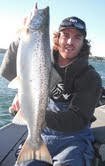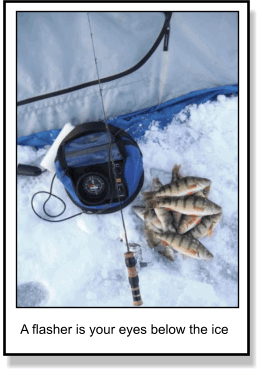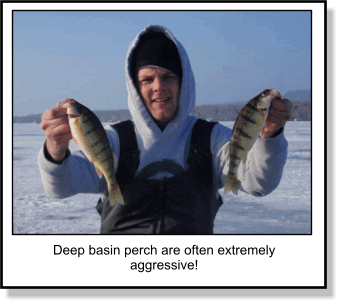|

Ontario Ice Fishing Huts and Rentals
|
 Winter
Perch Fishing Winter
Perch Fishing
By: Tyler Dunn
Tyler Dunn Guiding
 Perch
can be a funny bunch. Doesnít it seem like you
catch more of them when targeting other species
instead of when youíre actually fishing for
perch? Most of the time when I am actually
targeting yellow perch, I will routinely put in
a full day on the ice punching dozens of holes
searching for signs of a school. It is actually
quite the accomplishment to consistently catch
perch throughout the entire winter season. One,
I havenít yet mastered. The following tips are
for techniques I used successfully when Iím
trying to master winter perch on Lake Superior
and the bays of Lake George. Perch
can be a funny bunch. Doesnít it seem like you
catch more of them when targeting other species
instead of when youíre actually fishing for
perch? Most of the time when I am actually
targeting yellow perch, I will routinely put in
a full day on the ice punching dozens of holes
searching for signs of a school. It is actually
quite the accomplishment to consistently catch
perch throughout the entire winter season. One,
I havenít yet mastered. The following tips are
for techniques I used successfully when Iím
trying to master winter perch on Lake Superior
and the bays of Lake George.
Deep Basin Perch
Some of the finest perch fishing of the
year can be had on the deep basin portions of a
body of water. Usually during first ice and into
mid-winter perch can be found in depths of 60-80 feet in many lakes. This is where your power
auger is going to be a key ingredient for having
a successful day on the ice. Covering as much
water as you can until you land on top of them
is definitely the most efficient way to tackle
deep basin perch. Once you do find a school of
perch your next challenge is going to be getting
down to the strike zone. The quicker you get
down to the fish the better. The time it will
take for your lure to hit bottom cuts into your
catch rate. You can definitely still use the
same lures but most of the time on Superior
where I fish, I can bump up one size of Jigging
Rapala and get it down to the bottom much
faster. I love swimming lures but I especially
like them for deep water perch. Perch is my
favourite pattern with fluorescent orange a
close second. I jig aggressively while keeping a
close eye on my flasher trying to call in perch
from a distance. Once I mark fish or several
fish, I will continue to jig but with longer
pauses. Trying to get perch to rise off the
bottom is actually the most difficult task. Once
they do a strike will usually soon follow.
feet in many lakes. This is where your power
auger is going to be a key ingredient for having
a successful day on the ice. Covering as much
water as you can until you land on top of them
is definitely the most efficient way to tackle
deep basin perch. Once you do find a school of
perch your next challenge is going to be getting
down to the strike zone. The quicker you get
down to the fish the better. The time it will
take for your lure to hit bottom cuts into your
catch rate. You can definitely still use the
same lures but most of the time on Superior
where I fish, I can bump up one size of Jigging
Rapala and get it down to the bottom much
faster. I love swimming lures but I especially
like them for deep water perch. Perch is my
favourite pattern with fluorescent orange a
close second. I jig aggressively while keeping a
close eye on my flasher trying to call in perch
from a distance. Once I mark fish or several
fish, I will continue to jig but with longer
pauses. Trying to get perch to rise off the
bottom is actually the most difficult task. Once
they do a strike will usually soon follow.
Transition Perch
Perch moving from deep to shallow water
are what I like to call transition perch.
Simply, they are making the transition from deep
to shallow. There is a spot I like to fish, late
in the season. It is located directly in front
of a large weedy bay. I know that perch use this
bay to spawn and I try to cross paths with them
moving from the deep water, in. These perch
donít stick around for very long period of time.
A run and gun technique can either be a good or
really bad choice. Since the late season has
much warmer weather, I donít mind moving around.
If I find a spot that is getting consistent
flurries of fish every half hour or so, I will
set-up shop and wait for the schools as they
pass through.

Weed Perch
Although, I do catch perch in the weeds
throughout the entire winter, most of my success
will comes during the mid-late ice season. 15
feet and shallower is where I like to probe the
weed patches for perch. During mid-winter, I can
still find some nice, green weeds but into the
last month of the season this often changes. The
general rule is green is good and brown is bad.
Small spoons like forage minnows have a long,
narrow profile and great action for lightly
jigging up these weed perch. Small plastics such
as micro tube jigs and bug imitations are also a
good choice when targeting fish in weeds. On the
other hand, sand patches found in weed beds or
even near clusters of weeds offer a great spot
for perch to stalk and ambush unsuspecting prey.
If youíre using a flasher, you will notice that
most of the fish that come into view are
aggressive and anxious to hit your bait. They
donít need much, if anything to entice a strike.
These spots will also give you the opportunity
to use swimming bait, like a Jigging Rapala
which is my absolute favourite all around winter
perch lure.
|